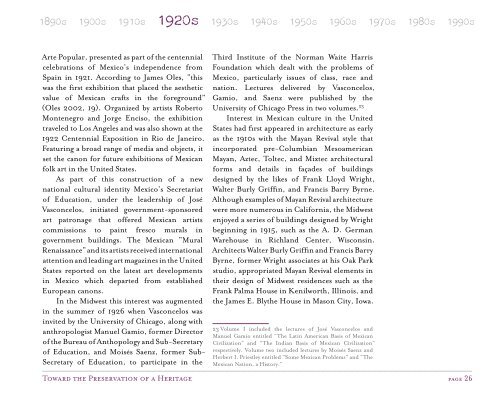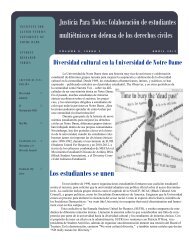Olga U. Herrera - The Institute for Latino Studies - University of Notre ...
Olga U. Herrera - The Institute for Latino Studies - University of Notre ...
Olga U. Herrera - The Institute for Latino Studies - University of Notre ...
You also want an ePaper? Increase the reach of your titles
YUMPU automatically turns print PDFs into web optimized ePapers that Google loves.
1890s 1900s 1910s 1920s 1930s 1940s 1950s 1960s 1970s 1980s 1990s<br />
Arte Popular, presented as part <strong>of</strong> the centennial Third <strong>Institute</strong> <strong>of</strong> the Norman Waite Harris<br />
celebrations <strong>of</strong> Mexico’s independence from Foundation which dealt with the problems <strong>of</strong><br />
Spain in 1921. According to James Oles, “this Mexico, particularly issues <strong>of</strong> class, race and<br />
was the first exhibition that placed the aesthetic nation. Lectures delivered by Vasconcelos,<br />
value <strong>of</strong> Mexican crafts in the <strong>for</strong>eground” Gamio, and Saenz were published by the<br />
(Oles 2002, 19). Organized by artists Roberto <strong>University</strong> <strong>of</strong> Chicago Press in two volumes.<br />
Montenegro and Jorge Enciso, the exhibition<br />
traveled to Los Angeles and was also shown at the<br />
1922 Centennial Exposition in Rio de Janeiro.<br />
Featuring a broad range <strong>of</strong> media and objects, it<br />
set the canon <strong>for</strong> future exhibitions <strong>of</strong> Mexican<br />
folk art in the United States.<br />
As part <strong>of</strong> this construction <strong>of</strong> a new<br />
national cultural identity Mexico’s Secretariat<br />
<strong>of</strong> Education, under the leadership <strong>of</strong> José<br />
Vasconcelos, initiated government-sponsored<br />
art patronage that <strong>of</strong>fered Mexican artists<br />
commissions to paint fresco murals in<br />
government buildings. <strong>The</strong> Mexican “Mural<br />
Renaissance” and its artists received international<br />
attention and leading art magazines in the United<br />
States reported on the latest art developments<br />
in Mexico which departed from established<br />
European canons.<br />
In the Midwest this interest was augmented<br />
in the summer <strong>of</strong> 1926 when Vasconcelos was<br />
invited by the <strong>University</strong> <strong>of</strong> Chicago, along with<br />
anthropologist Manuel Gamio, <strong>for</strong>mer Director<br />
<strong>of</strong> the Bureau <strong>of</strong> Anthopology and Sub-Secretary<br />
<strong>of</strong> Education, and Moisés Saenz, <strong>for</strong>mer Sub-<br />
Secretary <strong>of</strong> Education, to participate in the<br />
____________________________________________________________________________<br />
Toward the Preservation <strong>of</strong> a Heritage page 26<br />
23<br />
Interest in Mexican culture in the United<br />
States had first appeared in architecture as early<br />
as the 1910s with the Mayan Revival style that<br />
incorporated pre-Columbian Mesoamerican<br />
Mayan, Aztec, Toltec, and Mixtec architectural<br />
<strong>for</strong>ms and details in façades <strong>of</strong> buildings<br />
designed by the likes <strong>of</strong> Frank Lloyd Wright,<br />
Walter Burly Griffin, and Francis Barry Byrne.<br />
Although examples <strong>of</strong> Mayan Revival architecture<br />
were more numerous in Cali<strong>for</strong>nia, the Midwest<br />
enjoyed a series <strong>of</strong> buildings designed by Wright<br />
beginning in 1915, such as the A. D. German<br />
Warehouse in Richland Center, Wisconsin.<br />
Architects Walter Burly Griffin and Francis Barry<br />
Byrne, <strong>for</strong>mer Wright associates at his Oak Park<br />
studio, appropriated Mayan Revival elements in<br />
their design <strong>of</strong> Midwest residences such as the<br />
Frank Palma House in Kenilworth, Illinois, and<br />
the James E. Blythe House in Mason City, Iowa.<br />
23 Volume I included the lectures <strong>of</strong> José Vasconcelos and<br />
Manuel Gamio entitled “<strong>The</strong> Latin American Basis <strong>of</strong> Mexican<br />
Civilization” and “<strong>The</strong> Indian Basis <strong>of</strong> Mexican Civilization”<br />
respectively. Volume two included lectures by Moisés Saenz and<br />
Herbert I. Priestley entitled “Some Mexican Problems” and “<strong>The</strong><br />
Mexican Nation, a History.”



